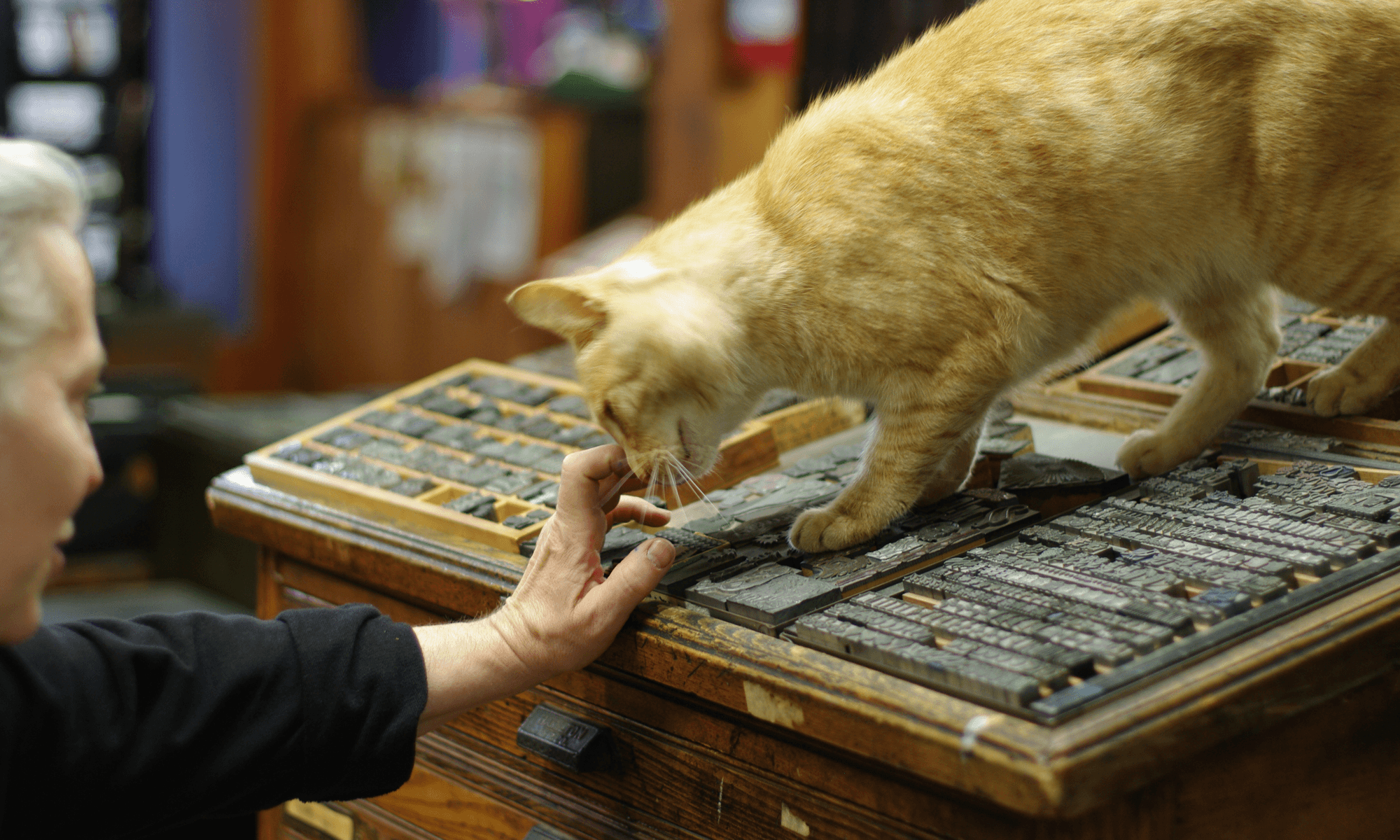Custom letterpress printing is our main purview! Business cards, wedding invitations, letterhead, book covers, event invites, broadsides, holiday cards, small specialty packaging, paper bag imprints, CD and LP sleeves, stamps, quilting squares—if you’ve thought of it, Day Moon Press has probably printed it or something very like it at some point in the last 40 years.
Design Process
We are happy to enter into a project at any stage, from diaphanous concept to finished art files! No matter where you are in the design process, we’ll start with an email or phone call to outline the scope, and establish which of our skills and materials your project requires. Frequently, if at all possible, the next step is an in-person visit to the shop—here we can assemble a set of samples of papers and similar projects most relevant to yours, and you can assess all the tactile aspects of surface texture, impression, and scale that are so important in letterpress printing.
In general, there are two paths for custom printing with us: assembling handset type from our library of fonts, decorative material, and engravings; or, converting a digital design directly into relief plates.
Working with handset type


Handset design is a collaborative process! We have a large library and it’s very time-intensive to set up even a basic proof, so the more we know about your project and design priorities, the more guidance we can give about what fonts and decorative materials are available and appropriate. We have proofs and specimen sheets of most of the library and can send you photographs or scans that suit your project—or you can design a little more like we do for ourselves, and visit the shop for a guided perusal of the collection in all its cases and galleys.

Digital design to relief plate


We’re also ready to print from a digital design provided, or to work with you to design a letterpress-appropriate file. If you’re providing files and have any questions about what constitutes a design well-suited to letterpress, please ask! The earlier in the process we can answer those kinds of questions, the better equipped we’ll be to deliver a product that matches your design concept. When we have finished art files (preferably as an .ai or .indml, with packaged fonts or expanded type), we’ll make a few preparatory tweaks and send them to our local platemaker, who will reliably have them mailed to us and ready to print within two business days.
Press checks
With either handset or plates, the customer is welcome to come for a press check before final printing. The proofs we send by email or text are often very rough—mostly useful for proofreading and determining position, not for color or paper—so a press check is the only time for the customer to see the job with the right paper and color, in person. Press checks are arranged by appointment, and scheduled so that we can print the job directly after approval.
Early design questions
If you are early enough in your project design process that you are not sure which method is most appropriate, here are some of the main advantages and limitations to each:
- Handset type generally cannot be punched as hard as a plate! We love our collection, and would like it to last as long as possible, without getting smashed. Plates have sturdier edges than lead or wood, and can also be remade easily.
- Typesetting by hand costs in time; typesetting for a plate costs by the square inch. For example: long copy or major revisions in handset type can be costly, but a digital file doesn’t care about character count and can be revised easily up until it’s etched. On the other hand, large-scale printing is set easily in big handset type, while a plate for a poster scale could be more expensive.
- Plates require at least 2 business days for production and delivery. Handset, depending on scale, can be done day-of.
- Our handset type library is very large but can’t possibly be as large as a digital one. There simply isn’t room.
- For small amounts of copy, frequent changes are easily made in handset. To change a phone number on a handset business card, we simply replace characters; in a plate we have to revise the file and re-order a whole new plate.
- Handset type is authentically, literally old. It was designed with the printing machinery in mind, and resolves for you many design choices that otherwise puzzle or challenge the printing process.
Things we do in-house:
- Digital design
- Die cutting
- Embossing & debossing
- Print from handset type, plates, linoleum blocks, wood blocks
- Wire binding
- Pamphlet wire stitching
- Hand-done bindery
Things we do not do but can outsource in combination with our work:
- Digital or offset printing
- Foil stamping
- Perfect binding
Estimates
We don’t provide generic estimates here—every project is extremely unique, and very basic design elements like the number of colors or amount of copy can have a much more drastic impact on price than things like quantity. If your design parameters are complete when you contact us (final design files, final copy, quantity, and at least a general preference on paper type) we can put together a quote from there; otherwise we’ll put together a skeleton of an estimate when we do our initial meeting with samples. Given broad strokes to work from, we can always give a range of quotes demonstrating pricing for different design choices: the difference between a 2- and 3-color design, for example, or different paper selection. We’re also always open to working backwards from a budget, and happy to break down an estimate to determine how much of the cost is allocated to different parts of the printing process or design.
Custom sample library















You must be logged in to post a comment.